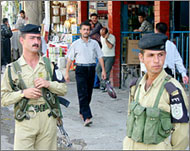Hearts and Minds – US style
As American troops exit the former Presidential Palace complex in Tikrit, the last thing they see emblazoned above the arched gateway is the Fourth Infantry Division motto: Strike First.

Since the last of the organised Iraqi military resistance was crushed in late April, these expansive palace grounds have been the headquarters for the US Fourth Division.
As the birthplace of ousted president Saddam Hussein, Tikrit has proven to be a hotbed of Iraqi resistance throughout the US occupation.
I asked my escort Specialist Jack Craig, a military policeman from Minnesota, how he correlated the “strike first” directive with the US military’s current policy of attempting to win the “hearts and minds” of the local population.
“Actually, I see ‘hearts and minds’ as a tactical doctrine. To me, it means that’s where we should aim first,” said Craig. “Shoot them in the body or in the head, but just make sure you shoot them first.”
Dangerous mentality
From his humourless expression, I presumed that he wasn’t joking.
“We have two major factors effecting the ability for some of our troops to understand restraint,” said Eddie Calis, the civilian security adviser at the US airbase at Kirkuk, in northern Iraq.
“One problem is that a lot of our soldiers are shit-scared and want to get out of here alive, no matter what that entails.
|
“I see ‘hearts and minds’ as a tactical doctrine. To me, it means that’s where we should aim first. Shoot them in the body or in the head, but just make sure you shoot them first” Specialist Jack Craig, |
“The second and much less widespread issue is that of misplaced patriotism,” said Calis, giving as an example one of the soldiers stationed at the Kirkuk airfield will soon be rotated back to America, and who feels that he has yet to fulfil his national duty.
“Every day he complains that he has not yet had the opportunity to kill an Iraqi, and do his bit for the war,” explained Calis.
Provoking a shooting
“On several recent occasions he has initiated provocation deliberately with local drivers at the gate, and I only hope that [this soldier] will be sent home before he fulfils his quest at the cost of an innocent life.”
However, aggressive and violent behaviour on the part of individual soldiers are not the only contributors to the American alienation of the local people.
In recent weeks, the Kirkuk airbase has come under almost daily attacks by Iraqi resistance fighters.
The increase in hostilities has been attributed to an influx of foreign Arab resistance fighters into the Kirkuk area. In an attempt to apprehend the perpetrators, the US offered a $50 cash bonus to the local police force for each suspect arrested.
Paid to arrest … anyone
Unfortunately, the post-war Kirkuk police force has been almost entirely recruited from the ethnic Kurdish minority. With little love for their Arab neighbours, the police wasted no time in collecting the promised bounty.
“The very next day the Kurdish police showed up with three badly beaten Arabs – one of whom had been shot in the arm – claiming that they were ‘Saddam loyalists’,” said Eddie Calis.
Although the reward was paid, the three men were cleared after a brief interrogation.
 |
|
US policy at one time was to pay |
“They were completely innocent, so we released them immediately. Unfortunately, the image of beaten US captives will not improve our standing and trust with the local Arabs.”
The unofficial policy of cash rewards was also quickly revoked, “but the damage was already done,” said Calis.
Public relations meltdown
With the US military suffering from such public relations setbacks, the stiffening resistance has taken on almost mythical qualities amongst the Iraqi population.
Explosions and gunfire routinely erupt in Baghdad, followed by the sound of sirens and helicopters. Whether or not these attacks actually target US personnel or cause any casualties is almost irrelevant.
The perception remains that the Americans are suffering serious casualties.
“There are many more dead and wounded US soldiers than they admit to,” said Anmar Saadi, a 43-year-old former Iraqi soldier.
Living close to the US-controlled airport and a major highway intersection, Saadi has witnessed numerous attacks against American convoys during the nine months of US occupation.
US media blackout
“Often the attacks I see are not reported in the Western media,” said Saadi.
The local media on the other hand often glorify resistance strikes, by detailing how rockets were deceptively deployed by the use of donkey carts and portraying the random ambushes as being part of a well-orchestrated guerrilla campaign.
“At the moment, the Iraqi resistance has the upper hand in this struggle,” said Jabar Abu Marwan, a former senior officer with Saddam’s Mukhabarat (the Iraqi secret service).
“Both the resistance and the US countermeasures are putting civilians at risk and creating collateral damage. However, while the Americans have failed to win the hearts of Iraqis, the resistance has at least captured their imaginations.”
Scott Taylor is the author of “Spinning on the Axis of Evil: America’s War Against Iraq”, published by Esprit de Corps Books.